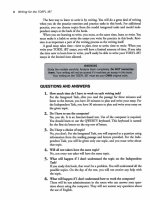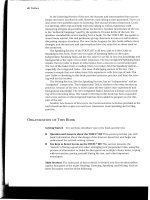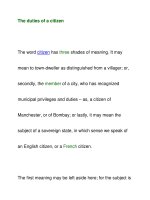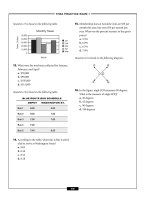Using the process of elimination 2 pot
Bạn đang xem bản rút gọn của tài liệu. Xem và tải ngay bản đầy đủ của tài liệu tại đây (67.61 KB, 6 trang )
Section 3: Writing (Part A—
Multiple-Choice)
Questions 1–3 are based on the following passage.
(1) Greyhound racing is the sixth most popular
spectator sport in the United States. (2) Over the last
decade, a growing number of racers have been
adopted to live out retirement as household pets,
once their racing career is over.
(3) Many people hesitate to adopt a retired
racing greyhound because they think only very old
dogs are available. (4) People also worry that the
greyhound will be more nervous and active than
other breeds and will need a large space to run. (5)
_________________. (6) In fact, racing greyhounds
are put up for adoption at a young age; even cham-
pion racers, who have the longest careers, only work
until they are about three-and-a-half years old. (7)
Since greyhounds usually live to be 12–15 years old,
their retirement is much longer than their racing
careers. (8) Far from being nervous dogs, grey-
hounds have naturally sweet, mild dispositions, and,
while they love to run, they are sprinters rather than
distance runners and are sufficiently exercised with
a few laps around a fenced-in backyard everyday.
(9) Greyhounds do not make good watchdogs,
but they are very good with children, get along well
with other dogs (and usually cats as well), and are
very affectionate and loyal. (10) A retired racing
greyhound is a wonderful pet for almost anyone.
1. Which part, if inserted in the blank space labeled
Part 5, would best help to focus the writer’s argu-
ment in the second paragraph?
a. Even so, greyhounds are placid dogs.
b. These worries are based on false impressions
and are easily dispelled.
c. Retired greyhounds do not need race tracks to
keep in shape.
d. However, retired greyhounds are too old to
need much exercise.
2. Which of the following changes is needed in the
first paragraph?
a. Part 2: Change growing to increasing.
b. Part 2: Change their to there.
c. Part 1: Change is to was.
d. Part 2: Change have to has.
3. Which of the following parts, if added between
Parts 9 and 10 of the third paragraph, would be
most consistent with the writer’s purpose, tone,
and intended audience?
a. Former racing dogs make up approximately
0.36% of all dogs owned as domestic pets in
the United States.
b. Despite the fact that greyhounds make excel-
lent domestic pets, there are still a large num-
ber of former racers who have not been
adopted.
c. Good-natured and tolerant dogs, greyhounds
speedily settle into any household, large or
small; they are equally at ease in an apartment
or a private home.
d. It is imperative that people overcome the
common myths they harbor about grey-
hounds that are preventing them from adopt-
ing these gentle dogs.
Questions 4–6 are based on the following passage.
(1) Following a recent series of arson fires in public-
housing buildings, the mayor of Crasonville has
decided to expand the city’s Community Patrol,
made up of 18- to 21-year-olds, to about 400 people.
(2) The Community Patrol has been an important
part of the city’s efforts to reduce the number of
arson crimes.
(3) In addition to the expanded patrol, the city
also has decided to reduce the seriousness of these
fires, most often set in stairwells, by stripping the
paint from the stairwell walls. (4) Fed by the thick
layers of oil-based paint, these arson fires race up the
stairwells at an alarming speed. (5) Fire retardant
– THEA PRACTICE EXAM 1–
45
failed to work in almost all cases. (6) When the city
attempted to control the speed of these fires by cov-
ering walls with a flame retardant. (7) In the most
recent fire, the flames raced up ten stories after the
old paint under the newly applied fire retardant
ignited. (8) Because the retardant failed to stop the
flames, the city has decided to stop applying it and
will now strip the stairwells down to the bare walls.
4. Which part in the second paragraph is not stan-
dard written English?
a. Part 8
b. Part 6
c. Part 5
d. Part 7
5. Which of the following changes should be made
to Part 3 of the passage?
a. Remove the word also.
b. Change patrol to patrols.
c. Change has decided to decided.
d. Remove the word these.
6. Which of the following parts, if inserted between
Part 2 and Part 3 of the passage, would best
develop the ideas in the first paragraph?
a. The Community Patrol keeps up a twenty-
four hour a day watch of derelict buildings in
four of the city’s boroughs.
b. The additional Community Patrol members
effectively increases the Patrol’s size by 25
percent.
c. The Community Patrol has already reduced
arson fires by 20% in certain neighborhoods;
increasing the Patrol numbers will allow the
city to extend this protection to all city
boroughs.
d. The increase in the Community Patrol also
helps to lower unemployment among
Crasonville’s youth; this makes the increase a
popular decision, enhancing the mayor’s
reputation with voters.
Questions 7 and 8 are based on the following passage.
(1) Yesterday I was exposed to what was called, in a
recent newspaper ad for Dilly’s Deli, “a dining expe-
rience like no other.”(2) I decided on the hamburger
steak special, the other specials were liver and onions
and tuna casserole. (3) Each special is offered with
two side dishes, but there was no potato salad left
and the green beans were cooked nearly beyond
recognition. (4) I chose the gelatin of the day and
what turned out to be the blandest coleslaw I have
ever eaten.
(5) At Dilly’s you sit at one of the four long
tables. (6) The couple sitting across from me was
having an argument. (7) The truck driver sitting
next to me told me more than I wanted to know
about highway taxes. (8) A
fter tasting each of the
dishes on my plate, it was time to leave; at that
moment, one of the people working behind the
counter yelled at me to clean up after myself. (9)
Throwing away that plate of food was the most
enjoyable part of dining at Dilly’s.
7. Which of the following changes should be made
to Part 2 of the first paragraph?
a. Replace were with are.
b. Replace the comma with a dash.
c. Replace I decided with Deciding.
d. Replace the comma with a semicolon.
8. Which of the following words or phrases should
replace the underlined words in Part 8 of the sec-
ond paragraph?
a. Having tasted
b. After I tasted
c. Tasting
d. After having tasted
– THEA PRACTICE EXAM 1–
46
Questions 9–11 are based on the following passage.
(1) Although most people are exercising regularly,
experts note that eating right is also a key to good
health. (2) Nutritionists recommend the “food pyra-
mid” as a simple guide to eating the proper foods. (3)
At the base of the food pyramid are grains and fiber.
(4) People should eat six to eleven servings of bread,
cereal, rice, and pasta everyday. (5) Servings of veg-
etables and fruit, the next level up the pyramid
should be eaten five to nine times per day. (6) The
next pyramid level is the dairy group. (7) Two or
three servings a day of milk, yogurt, or cheese help
maintain good nutrition. (8) Moving up the pyra-
mid, the next level is the meat, poultry, fish, beans,
eggs, and nuts group, of which everyone should eat
only two to three servings a day. (9) At the very top
of the pyramid is fats, oils, and sweets; these foods
should be eaten only infrequently.
(10) ________________________________.
(11) If they follow the pyramid’s guidelines, people
do not have to shop in health food or specialty stores.
(12) People need only stay in the outer two or three
aisles of the supermarket, where the healthiest foods
are located.
9. Which of the following revisions is necessary in
Part 9 of the passage?
a. At the very top of the pyramid is fats, oils and
sweets; these foods should be eaten only
infrequently.
b. At the very top of the pyramid are fats, oils,
and sweets; these foods should be eaten only
infrequently.
c. At the very top of the pyramid is fats, oils, and
sweets; these foods must be eaten only
infrequently.
d. At the very top of the pyramid is fats, oils, and
sweets; only these foods should be eaten
infrequently.
10. Which of the following parts, if inserted in the
blank line numbered Part 10, would be most
consistent with development and grammar of
the paragraph?
a. The nutrition plan set out in the food pyramid
was designed to make it easy to fit good nutri-
tion habits into your already too complicated
lives.
b. Unlike fad diets and weighty books of calorie
counts, the food pyramid is a clear visual aid
that will help people remember the essentials
of healthy eating.
c. While the food pyramid can help you learn
how to eat more healthily, it cannot replace
the necessity of exercise.
d. The nutrition plan set out in the food pyramid
was designed to make it easy to fit good nutri-
tion habits into people’s already too compli-
cated lives.
11. Which of the following changes is needed in the
above passage?
a. Part 5: Insert comma after pyramid.
b. Part 1: Replace most with more.
c. Part 8: Replace of which with which.
d. Part 8: Insert a colon after is.
Questions 12 and 13 are based on the following passage.
(1) Police officers must read suspects their Miranda
rights upon taking them into custody. (2) When a
suspect who is merely being questioned incr
imi-
nates himself, he might later claim to have been in
custody and seek to have the case dismissed on the
grounds of not having been ap
praised of his
Miranda rights.
(3) In such cases, a judge must make a deter-
mination as to whether or not a reasonable person
would have believed himself to have been in custody,
based on certain criteria. (4) Officers must be aware
of these cr
iteria and take care not to give suspects
– THEA PRACTICE EXAM 1–
47
grounds for later claiming they believed themselves
to be in custody.
(5) The judge must asc
ertain whether the sus-
pect was questioned in a threatening manner (for
example, if the suspect was seated while both officers
remained standing) and whether the suspect was
aware that he or she was free to leave at any time.
12. Which of the underlined words in the passage
should be replaced by a more appropriate, accu-
rate word?
a. incriminates
b. appraised
c. criteria
d. ascertain
13. Which of the following changes would make the
sequence of ideas in the passage clearer?
a. Place Part 5 after Part 1.
b. Reverse Parts 3 and 5.
c. Reverse the order of Parts 4 and 5.
d. Delete Part 2.
Questions 14 and 15 are based on the following passage.
(1) An ecosystem is a group of animals and plants
living in a specific region and interacting with one
another and with their physical environment. (2)
Ecosystems include physical and chemical compo-
nents, such as soils, water, and nutrients that support
the organisms living there. (3) These organisms may
range from large animals to microscopic bacteria. (4)
Ecosystems also can be thought of as the interacting
among all organisms in a given habitat; for instance,
one species may serve as food for another. (5) Peo-
ple are part of the ecosystems where they live and
work. (6) Environmental Groups are forming in
many communities. (7) Human activities can harm
or destroy local ecosystems unless actions such as
land development for housing or businesses are
carefully planned to conserve and sustain the ecology
of the area. (8) An important part of ecosystem
management involves finding ways to protect and
enhance economic and social well-being while pro-
tecting local ecosystems.
14. Which of the following numbered parts is
LEAST relevant to the main idea of the para-
graph?
a. Part 1
b. Part 6
c. Part 7
d. Part 8
15. Which of the following changes is needed in the
passage?
a. Part 5: Place a comma after live.
b. Part 2: Remove the comma after water.
c. Part 6: Use a lower case g for the word Group.
d. Part 8: Change involves to involved.
Questions 16 and 17 are based on the following passage.
(1) Courts allow hearsay evidence (secondhand
reporting of a statement) only when the truth of
the statement is irrelevant. (2) Hearsay that depends
on the statement’s truthfulness, is inadmissible
because the witness does not appear in court and
swear an oath to tell the truth. (3) Because his
demeanor when making the statement is not visible
to the jury, the accuracy of the statement cannot be
tested under cross-examination, and to introduce it
would deprive the accused of the constitutional right
to confront the accuser. (4) The courtroom
demeanor of a witness is crucial to a lawyer’s con-
vincing a jury of the veracity of his case. (5) Hearsay
is admissible, however, when the truth of the state-
ment is unimportant. (6) For example, if a defen-
dant claims he was unconscious at a certain time, but
a witness claims that the defendant spoke to her at
that time, this evidence would be admissible because
the truth of what the defendant said is irrelevant.
– THEA PRACTICE EXAM 1–
48
16. Which of the following numbered parts is
LEAST relevant to the main idea of the
paragraph?
a. Part 4
b. Part 6
c. Part 1
d. Part 5
17. Which of the following changes is needed in the
passage?
a. Part 5: Remove the comma after however.
b. Part 3: Remove the comma after jury.
c. Part 2: Remove the comma after truthfulness.
d. Part 1: Remove the comma after statement.
Questions 18 and 19 are based on the following passage.
(1) There are two types of diabetes, insulin-depend-
ent and non-insulin-dependent. (2) Between 90 and
95 percent of the estimated 13 to 14 million people
in the United States with diabetes have non-insulin-
dependent, or Type II, diabetes. (3) Because this
form of diabetes usually begins in adults over the age
of 40 and is most common after the age of 55, it used
to be called adult-onset diabetes. (4) ________ its
symptoms often develop gradually and are hard to
identify at first, ________, nearly half of all people
with diabetes do not know they have it. (5)
________, someone who has developed Type II dia-
betes may more feel tired or ill without knowing
why. (6) This can be particularly dangerous because
untreated diabetes can cause damage to the heart,
blood vessels, eyes, kidneys, and nerves. (7) While
the causes, short-term effects, and treatments of the
two types of diabetes differ, both types can cause the
same long-term health problems.
18. Which of the following parts of the paragraph
contains an incomplete or illogical comparison?
a. Part 7
b. Part 5
c. Part 3
d. Part 2
19. Which sequence of words, if inserted into the
blanks in the paragraph, helps the reader under-
stand the sequence and logic of the writer’s ideas?
a. Since therefore For example
b. While however Next
c. Moreover . . . as a result Eventually
d. Because nevertheless Thus
Questions 20–22 are based on the following passage.
(1) By using tiny probes as neural prostheses, scien-
tists may be able to restore nerve function in quad-
riplegics, make the blind see, or the deaf hear. (2)
Thanks to advanced techniques, an implanted probe
can stimulate individual neurons electrically or
chemically and then record responses. (3) Prelimi-
nary results suggest that the microprobe telemetry
systems can be permanently implanted and replace
damaged or missing nerves.
(4) The tissue-compatible microprobes rep-
resent an advance over the typically aluminum wire
electrodes used in studies of the cortex and other
brain structures. (5) Previously, researchers data
was accumulated using traditional electrodes, but
there is a question of how much damage they cause
to the nervous system. (6) Microprobes, since they
are slightly thinner than a human hair, cause mini-
mal damage and disruption of neurons when
inserted into the brain because of their diminutive
width.
(7) In addition to recording nervous system
impulses, the microprobes have minuscule chan-
nels that open the way for delivery of drugs, cellular
growth factors, neurotransmitters, and other neu-
roactive compounds to a single neuron or to groups
of neurons. (8) The probes usually have up to four
channels, each with its own recording/stimulating
electrode.
– THEA PRACTICE EXAM 1–
49
20. Which of the following changes is needed in the
passage?
a. Part 8: Change its to it’s.
b. Part 6: Change their to its.
c. Part 6: Change than to then.
d. Part 5: Change researchers to researchers’.
21. Which of the following parts uses an adverb
incorrectly?
a. Part 2
b. Part 8
c. Part 6
d. Part 4
22. Which of the following numbered parts should
be revised to reduce unnecessary repetition?
a. Part 5
b. Part 6
c. Part 2
d. Part 8
Questions 23–25 are based on the following passage.
(1) Loud noises on buses not only irritate passengers
but also create unsafe situations. (2) They are pro-
hibited by law and by agency policy. (3) Therefore,
bus operators are expected to follow the procedures
outlined below.
(4) A passenger-created disturbance is by play-
ing excessively loud music or creating loud noises in
some other manner. (5) In the event a passenger
creates a disturbance, the bus operator will politely
ask the passenger to turn off the music or stop mak-
ing the loud noise. (6) If the passenger refuses to
comply, the bus operator will tell the passenger that
he or she is in violation of the law and bus policy and
will have to leave the bus if he or she will not com-
ply to the request. (7) If police assistance is
requested, the bus operator will stay at the location
from which the call to the Command Center was
placed or the silent alarm used. (8) The bus opera-
tor will wait there until the police arrive, will allow
passengers off the bus at this point, and no passen-
gers are allowed on until the situation is resolved.
23. Which of the following numbered parts contains
a sentence fragment?
a. Part 4
b. Part 7
c. Part 3
d. Part 6
24. Which of the following is the best revision of the
sentence numbered Part 8 in the passage?
a. Bus operators will wait there until the police
arrive, will allow passengers off the bus at this
point, and no passengers will be allowed on
until the situation is resolved.
b. Bus operators will wait there until the police
arrive, will allow passengers off the bus at this
point, and, until the situation is resolved, no
passengers are allowed on.
c. Bus operators will wait there until the police
arrive, will allow passengers off the bus at this
point, and will not allow passengers on until
the situation is resolved.
d. Bus operators will wait there until the police
arrive, will allow passengers off the bus at this
point, and no passengers will be allowed on
until the situation is resolved.
25. Which of the following numbered parts uses a
preposition incorrectly?
a. Part 2
b. Part 6
c. Part 3
d. Part 8
– THEA PRACTICE EXAM 1–
50









